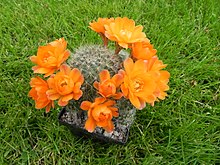| Aylostera | |
|---|---|

| |
| Aylostera deminuta | |
| Scientific classification | |
| Kingdom: | Plantae |
| Clade: | Tracheophytes |
| Clade: | Angiosperms |
| Clade: | Eudicots |
| Order: | Caryophyllales |
| Family: | Cactaceae |
| Subfamily: | Cactoideae |
| Tribe: | Cereeae |
| Subtribe: | Aylosterinae |
| Genus: | Aylostera Speg. |
| Type species | |
| Aylostera deminuta | |
| Synonyms | |
| |
Aylostera, is a genus of cactus, native to central Bolivia and north western Argentina. Aylostera was formerly sunk into a broadly circumscribed genus Rebutia, but molecular phylogenetic studies from 2007 onwards showed that when defined in this way, Rebutia was not monophyletic, leading to the resurrection of Aylostera. A 2023 classification of the tribe Cereeae placed it as the only genus in the subtribe Aylosterinae. It was formerly placed in the subtribe Rebutiinae.
Description
Aylostera species are small cacti with globular stems. The stems may or may not have ribs; this feature can vary even within a species. Their flowers are of various colours. A key feature that distinguishes Aylostera from Rebutia is that the pericarpels and receptacles (which together form a structure that is often referred to as the 'flower tube') are hairy, rather than glabrous.
Taxonomy
The genus Aylostera was erected by Carlo Luigi Spegazzini in 1923. A historical summary of the treatment of Aylostera and related genera published in 2011 showed how in succession it was recognized, sunk into Rebutia, and then resurrected to include a large part of Rebutia. A phylogenetic study in 2016 using both molecular and morphological characters confirmed that Aylostera was monophyletic and distantly related to the clade that contains the type species of Rebutia, thus justifying recognizing it as a separate genus. The separate status of Aylostera is accepted by Plants of the World Online, as of December 2024.
In a 2023 classification of the tribe Cereeae, it was placed as the only genus in the subtribe Uebelmanniinae, having formerly been placed in the subtribe Rebutiinae.
Species
The number of species accepted in Aylostera varies considerably. The 2016 study of the genus accepted only nine species, including a very broadly circumscribed Aylostera deminuta. As of December 2024, Plants of the World Online accepted 26 species:
| Image | Scientific name | Distribution |
|---|---|---|
 |
Aylostera albiflora (F.Ritter & Buining) Backeb. | Bolivia. |
 |
Aylostera albopectinata (Rausch) Mosti & Papini | Bolivia. |
 |
Aylostera atrovirens (Backeb.) Mosti & Papini | Bolivia to Argentina |
 |
Aylostera deminuta (F.A.C.Weber) Backeb. | Bolivia to Argentina |
 |
Aylostera einsteinii (Frič) Mosti & Papini | Bolivia to Argentina |
 |
Aylostera fiebrigii (Gürke) Backeb. | Bolivia to Argentina |
 |
Aylostera flavistyla (F.Ritter) Mosti & Papini | Bolivia |
| Aylostera fusca (F.Ritter) Mosti & Papini | Bolivia. | |
 |
Aylostera heliosa (Rausch) Mosti & Papini | Bolivia. |
| Aylostera hoffmannii (Diers & Rausch) Mosti & Papini | Bolivia to Argentina (Salta) | |
 |
Aylostera kupperiana (Boed.) Backeb. | Bolivia (Tarija) |
| Aylostera leucanthema (Rausch) Mosti & Papini | Bolivia (Chuquisaca) | |
| Aylostera malochii (Slaba & Lad.Fisch.) Ritz | Bolivia. | |
| Aylostera mamillosa (Rausch) Mosti & Papini | Bolivia | |
| Aylostera mandingaensis R.Wahl & Jucker | Bolivia. | |
 |
Aylostera muscula (F.Ritter & P.Thiele) Backeb. | Bolivia (Tarija) |
 |
Aylostera narvaecense Cárdenas | Bolivia (Tarija) |
 |
Aylostera nigricans (Wessner) Mosti & Papini | Argentina |
 |
Aylostera perplexa (Donald) Mosti & Papini | Bolivia. |
 |
Aylostera pseudominuscula (Speg.) Speg. | Bolivia to Argentina |
 |
Aylostera pulvinosa (F.Ritter & Buining) Backeb. | Bolivia (Tarija) |
 |
Aylostera pygmaea (R.E.Fr.) Mosti & Papini | Bolivia to Argentina |
 |
Aylostera spinosissima (Backeb.) Backeb. | Bolivia. |
 |
Aylostera steinmannii (Solms) Backeb. | Bolivia to Argentina |
 |
Aylostera tarvitaensis (F.Ritter) Mosti & Papini | Bolivia. |
| Aylostera tuberosa (F.Ritter) Backeb. | Bolivia. |
Distribution and habitat
Aylostera species are native to Bolivia and north-western Argentina. They are found on the cordilleras to the east of the Andes, from 17° south to 26° south, in montane dry forests, shrublands and dry puna grasslands.
References
- ^ "Aylostera". Plants of the World Online. Royal Botanic Gardens, Kew. Retrieved 15 December 2024.
- ^ Ritz, C.M.; Fickenscher, K.; Föller, J.; Herrmann, K.; Mecklenburg, R.; Wahl, R. (2016). "Molecular phylogenetic relationships of the Andean genus Aylostera Speg. (Cactaceae, Trichocereeae), a new classification and a morphological identification key". Plant Systematics and Evolution. 302 (7): 763–780. Bibcode:2016PSyEv.302..763R. doi:10.1007/s00606-016-1296-4. S2CID 16873446.
- Mosti, Stefano; Bandara, Nadeesha Lewke & Papini, Alessio (2011), "Further insights and new combinations in Aylostera (Cactaceae) based on molecular and morphological data", Pakistan Journal of Botany, 43 (6): 2769–2785, retrieved 2013-03-19
- Romeiro-Brito, Monique; Taylor, Nigel P.; Zappi, Daniela C.; Telhe, Milena C.; Franco, Fernando F. & Moraes, Evandro M. (2023). "Unravelling phylogenetic relationships of the tribe Cereeae using target enrichment sequencing". Annals of Botany. 132 (5): 989–1006. doi:10.1093/aob/mcad153. PMC 10808018.
| Taxon identifiers | |
|---|---|
| Aylostera | |
This Cactaceae article is a stub. You can help Misplaced Pages by expanding it. |